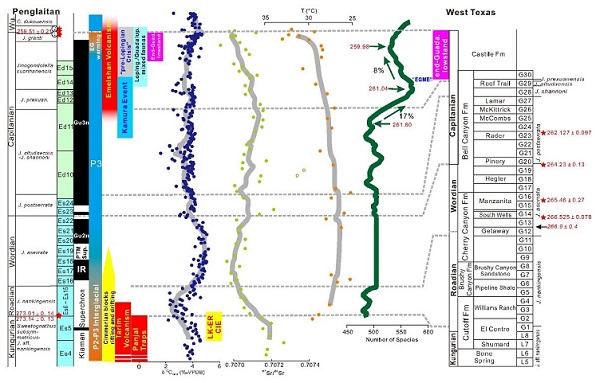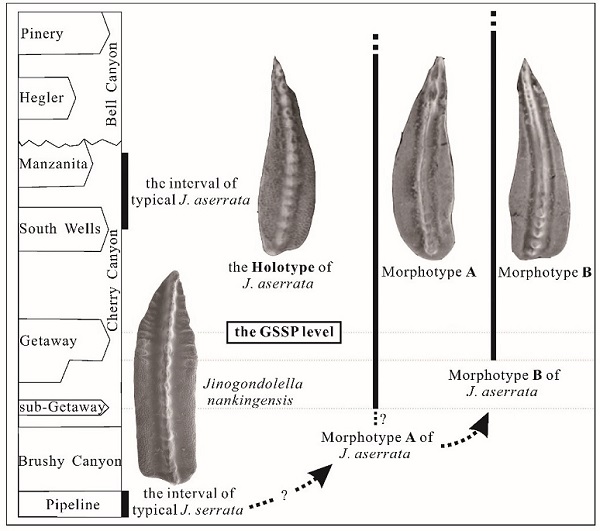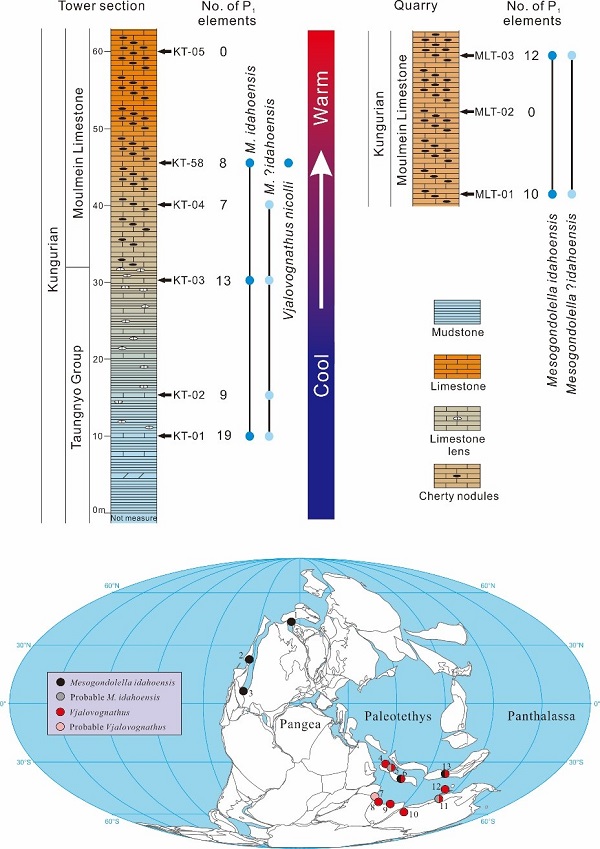Conodonts is one of the most important fossil groups of the Permian. At present, all the Global Stratotype Sections and Points (GSSPs) of the Permian are or will soon be defined by the first appearance datum of conodont species. Therefore, the study of conodonts is important for the Permian stratigraphic division and correlation.
Recently, Dr. YUAN Dongxun, Prof. ZHANG Yichun, Prof. ZHANG Hua, Prof. QI Yuping, Prof. WANG Yue and others from Nanjing Institute of Geology and Palaeontology, Chinese Academy of Sciences (NIGPAS), and other colleagues from Nanjing University, University of Calgary, Canada, University of Texas at San Antonio, Massachusetts Institute of Technology, USA, and Taunggyi University, Myanmar, have obtained a series of research data, which have been published in Earth-science Reviews, Newsletters on Stratigraphy, and Palaeogeography, Palaeoclimatology, Palaeoecology, based on conodont materials from South China, West Texas and eastern Myanmar.
Integrated timescale:
South China and West Texas have the most complete middle Permian strata of the global. However, strong provincialism by Pangaea makes the correlations between the Tethyan region and the North American successions difficult by using traditional ammonoids and fusulines. Thus, the conodonts become one important marker for the global correlation of the middle Permian strata. Here, based on the high-resolution conodonts biostratigraphy between South China and West Texas, combined with the ammonoids, fusulines, U-Pb ages, cyclostratigraphy, carbon and strontium isotopes of rocks and oxygen isotopes of conodonts, an integrated stratigraphic correlation framework of two regions has been established, and the Guadalupian correlation and major events have been discussed in detailed.
GSSP:
The three GSSPs of Guadalupian were ratified in West Texas twenty years ago. However, a formal GSSP description has not been published on any official peer-reviewed journasl so far, and conodonts have not been figured from the GSSP section. Based on current documentation from the Wordian GSSP section, it provides limited data for its global correlation, although it has been utilized as a GSSP for two decades.
In order to solve this problem, herein, we report our results from the GSSP section for the first time. We have found that the FOs of Morphotypes A and B of Jinogondolella aserrata occur lower in the section than the placement of the current GSSP and other fossil groups are absence except for the presence of sponge spicules. Conodonts from the Wordian GSSP level at the GSSP section are not present, despite the fact that large samples were processed in two labs of China and Canada. There is an inconsistency in the global correlation of the Wordian boundary in previous documents. Three ash beds have been collected, but no zircons were recovered. Data of carbon and strontium isotopes are affected by diagenesis, and cannot provide some significant markers for international correlation. The oxygen isotopes of conodont apatite are slightly higher than the data in this interval from South China.
Overall, the current GSSP section has a number of major shortcomings to provide an integrated stratigraphic framework as the standard of the Wordian Stage. New sections, in combination with improved systematics, should be searched for a better GSSP definition in the near future.
Paleobiogeography:
Due to the lack of conodonts data, the Permian strata division and international correlation are unclear for a long time in the eastern Myanmar, and it makes difficult to establish a high-resolution stratigraphic framework here, which indirectly hampers the study on paleogeographic evolution of the block. In this study, we report a Permian conodont group of the eastern Myanmar for the first time. Firstly, it restricts the age of the study interval and establishes stratigraphic correlation of this region. Secondly, based on the special conodont genus (e.g., Vjalovognathus), it indicates that the terrane accommodating this fauna in the eastern Myanmar has a close paleobiogeographic link to the northwestern Australia and Lhasa Block, which may indicate these tectonic units were paleogeographically close to one another during the late Cisuralian.
This work is supported by the Strategic Priority Research Programs of the Chinese Academy of Sciences, the Natural National Science Foundation of China, and the Second Tibetan Plateau Scientific Expedition and Research.
Reference:
Shen Shu-zhong*, Yuan Dong-xun*, Henderson C.M., Wu Qiong, Zhang Yi-chun, Zhang Hua, Mu Lin, Ramezani J., Wang Xiang-dong, Lambert L.L., Erwin D.H., Hearst J.M., Xiang Lei, Chen Bo, Fan Jun-xuan, Wang Yue, Wang Wen-qian, Qi Yu-ping, Chen Jun, Qie Wen-kun, Wang Tian-tian, 2020. Progresses, problems and prospects: An overview of the Guadalupian Series of South China and North America. Earth-Science Reviews, https://doi.org/10.1016/j.earscirev.2020.103412.
Yuan Dong-xun*, Shen Shu-zhong, Henderson C.M., Lambert L.L., Hearst J.M., Zhang Yi-chun, Chen Jun, Qie Wen-kun, Zhang Hua, Wang Xiang-dong, Qi Yu-ping, Wu Qiong, 2020. Reinvestigation of the Wordian-base GSSP section, West Texas, USA. Newsletters On Stratigraphy, DOI: 10.1127/nos/2020/0613.
Yuan Dong-xun, Kyi Pyar Aung, Henderson C.M., Zhang Yi-chun, Than Zaw, Cai Fulong, Ding Lin, Shen Shu-zhong*, 2020. First records of Early Permian conodonts from eastern Myanmar and implications of paleobiogeographic links to the Lhasa Block and northwestern Australia. Palaeogeography, Palaeoclimatology, Palaeoecology, 549: 109363. https://doi.org/10.1016/j.palaeo.2019.109363.

Guadalupian conodont, fusuline, ammonoid and radiolarian successions and their correlation between South China and West Texas

A summary for the temporal correlation of geologic, paleoclimatic and biological events between South China and West Texas during Guadalupian

The holotype and two morphotypes of Jinogondolella aserrata, their ranges and possible evolutionary lineage at the Wordian GSSP section

Ranges and paleogeographic distribution of the Cisuralian conodonts in the eastern Myanmar
Download:
